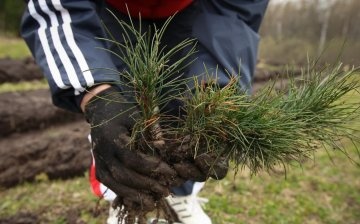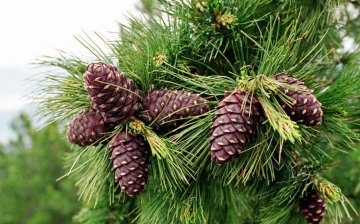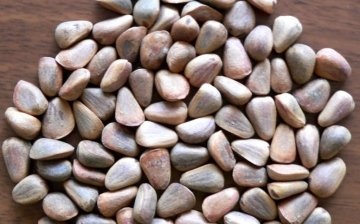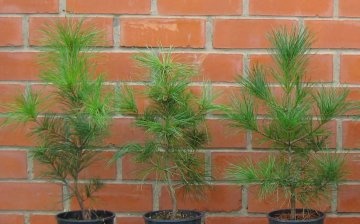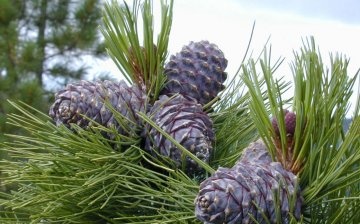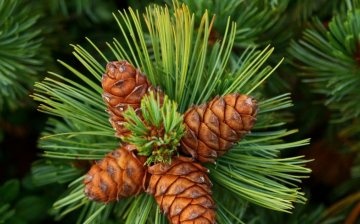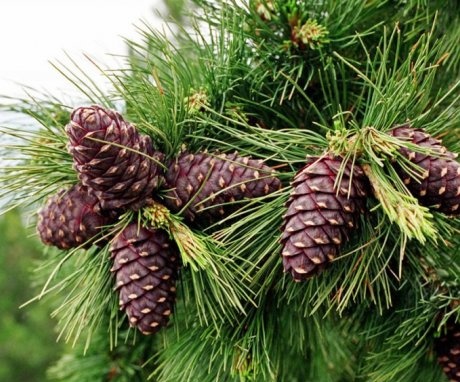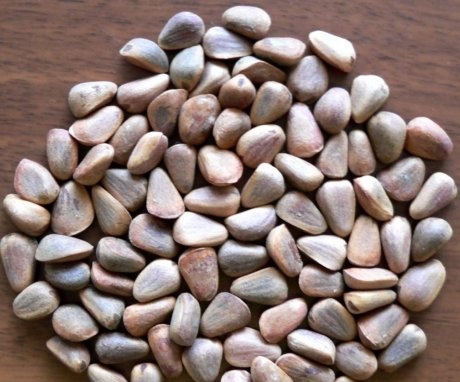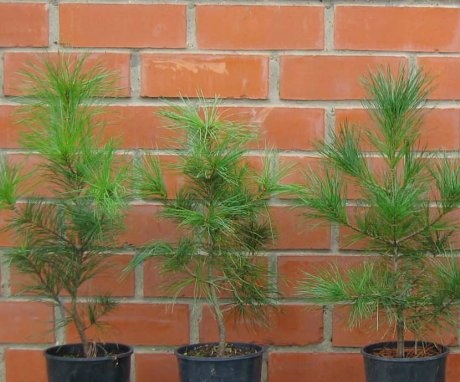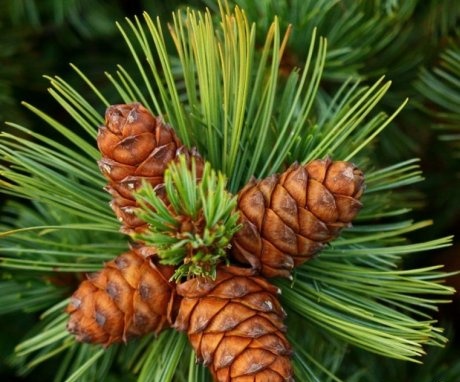How to properly plant a cedar in your area?
Cedars - evergreens with a conical crown, which are valued for strong quality wood, beautiful appearance.
Content:
- Description and the best varieties for growing
- Preparation and planting of seeds: terms and rules
- Planting a seedling
- Tips for caring for cedar
- Application of cedar
Description and the best varieties for growing
An interesting feature of the cedar: its needles are located on the branches in a spiral. The height of the Atlas and Atlantic cedar in places of natural growth (Morocco, Algeria) can reach 36 m, and a diameter of 1.5 m. Its branches grow faster than the trunk, which is reflected in the shape of the crown. And the Himalayan (India) grows up to 60 m with a diameter of 2 m. The branches grow high from the ground. The shape of the crown is pyramidal. In the northern regions, where the cedar is imported, it grows up to 20 m in height, and the side branches grow closer to the ground.
But there are also dwarf varieties that reach only 1 m in a lifetime.
There are slow-growing ones that resemble dwarf ones for a long time. Over time, the top of the cedar can change its shape and become flat. Cones grow on short branches. They mature in about 2 years.
All cedars are divided into types:
- Atlantic
- Atlas
- Deodar (Himalayan) up to 50 m. Cones are round, red-brown when mature. Withstands frosts down to -25 degrees. Loves moist soil and air.
- Lebanese up to 35 m high. Needles are tetrahedral, up to 10 cm long. Planted singly.
- Canadian red grows up to 70 m. Woods from beige to brown-red.
Tall varieties:
- Lebanese with horizontal branches. Unpretentious to growing conditions. Withstands frost up to 40 degrees. It grows very slowly, in 10 years it reaches 2 m. Originally from Lebanon, it grows on the Black Sea coast.
- The Himalayan has branches descending from top to bottom and a top directed upward. For 10 years it reaches 3 m.
- Atlas (Glauca cultivar) with branches growing upward. At a young age, he needs support. At the age of 10, its height is 3 m, but later it becomes powerful.
Dwarf cedar species:
- Lebanese Creeping Sardentii and Squat Nana.
- Atlas Glauca Pendula with bluish needles and blue cones and Aurea with yellow needles.
- The Himalayan Golden Horizon spreads along the ground. The needles become yellow in sunny areas.
Often cedars call trees similar to them in some respects. Usually these are conifers, but there are deciduous ones as well. Many cedars include cedar pine. It is more hardy and can grow in severe frosts. It grows in height up to 45 m. And it can live up to 700 years and longer. The needles are green with a bluish tinge, soft, 3-sided in section. The bark is gray with a brown tinge, cracking, forms scales. Root up to 50 cm long, with powerful lateral roots. Lateral roots keep the cedar from gusts of wind. The basal feet also contribute to this.
Siberian cedar begins to bear fruit at the age of 60. This is not surprising, because the cedar grows only a month and a half during the season. Male and female cones grow on the same tree. Pollination occurs under the influence of the wind. Buds mature in a year or more. On average, about 12 kg of them can be collected from one tree per season.
In nature, cedars reproduce by seeds.In nurseries, they are propagated by grafting. This accelerates the entry of the cedar into fruiting. It can occur at 5 years of age after vaccination. Siberian pine nuts can be grown from pine nuts that are found in cones. But not everyone agrees to wait for 50-60 years of harvest.
Preparation and planting of seeds: terms and rules
The cedar seeds are taken out of the cone. Examine them. They should be fresh, as evidenced by a pleasant smell. 3 months before sowing nuts stratify... The seeds are processed in a weakly borne solution of potassium permanganate for 2 hours. This will protect them from fungal infections. The seeds are placed in water, kept there for 3 days, changing the water daily. Mix the prepared seeds with washed river sand or peat. Take the volume of the mixture, 3 times the volume of the seeds. Moisten so that water does not drip from the mixture, clenched into a fist.
The mixture is placed in a wooden box, in the side walls of which there are holes for air intake.
Dry grass is laid at the bottom, and the seeds are covered with it from above. A couple of times a month, the seeds are moistened. The box is stored at a temperature of about 5 ° C in the cellar. You can leave it outside, but you need to protect it from rodents. After 3 months, the seeds are sown in the school. The soil should be light, loamy. You can add peat, sand.
Seeds are sown to a depth of 2 cm. sawdust... Gauze is pulled over the plot so that the birds do not gnaw the seedlings, and the sun's rays do not damage the young shoots. The shelter is removed after a month. After 3 years, the plants are transplanted into separate pots. Plants shade, potted soil moist.
Planting a seedling
Cedar grows well in well-drained light soils. The place for it is sunny.
Landing features:
- A seedling is planted in the ground at the age of 3 years. For a tree purchased from a closed-root nursery, the roots that are in a twisted state need to be smoothed out. They should not be bent. They are placed in the upper layers. The soil around the tree is mulched.
- Prepare a pit for planting in advance. The removed soil is mixed with sand, peat and wood ash... It is not recommended to add humus, because there may be pest larvae that can destroy the root of the tree. Wait at least 3 weeks for the soil to settle.
- Dig up the tree so that as much soil as possible remains near the root. Wrap the root with a lump of earth with a cloth. They are transferred to the place where the prepared pit is located. Place the tree in a hole, sprinkle with prepared soil. Consolidate it. Watering.
- It is imperative to observe the orientation in space. The part of the crown that was turned south should look in the same direction after transplanting.
- The distance between trees must be at least 4 m. From a tree to a house or other building there must be at least 3 m.
Sometimes nurseries sell trees up to 7 m high. They are necessarily sold with a closed root system. Such trees are planted in winter. For several years, the tree needs to be vigorously looked after.
Tips for caring for cedar
Greenhouse-grown cedar is hardened. To do this, he is taken out for several hours in fresh air. But they don't leave it overnight. Water constantly to keep the soil moist, but not wet. You cannot loosen it. No need to fertilize and feed.
The cedar must grow free, so you need to be careful not to be drowned out by other trees that grow much faster. Otherwise, he may die.
Mulch is constantly poured. This promotes lateral root growth.
Diseases and pests of cedar:
- Cedar is a plant that has a lot of pests. The most dangerous is the pine cone moth. To combat it, the tree is treated with lepidocide at the beginning of flowering and again after 7 days.
- Bark beetles can destroy a young tree. They find weak, recently planted cedars, dig holes in the roots, in which the females lay their eggs. The larvae that appear can destroy the cedar. Their appearance is evidenced by holes in the trunk, from which resin flows.It is very difficult to deal with them. You can spill with Aktara solution (2 liters under one tree).
- Another dangerous pest is Siberian hermes. It looks like the fluff that envelops the shoots. This fluff protects pests from common insecticides. Therefore, it is necessary to deal with it with substances that penetrate with the juice.
- Diseases of Siberian cedar - rust and blister rust of needles, and shoot cancer. For prophylaxis, care conditions are observed, plantings are thinned.
- The trunk of an old tree is affected by a pine sponge. This leads to fungal disease. The root sponge can infect the roots of the plant. Such trees must be removed from the site.
Application of cedar
Cedars are planted in the southern regions to decorate parks and gardens. The varieties with blue needles are especially beautiful. Atlas cedars grow in Crimea. The drought-resistant Lebanese cedar is grown in Central Asia.
- Cedars look beautiful in single and group plantings. The Himalayan cedar tolerates a haircut that gives its crown a varied shape. Used to form hedges.
- You can grow cedar in a room by making bonsai.
- Cedars are prized for their beautiful woods. In some species, it is also durable. Garden furniture is made from cedar, hedges, it is used in the construction of buildings and bridges.
- Siberian cedar pine is valued for its decorativeness, delicious pine nuts, oil made from them, resin and valuable wood. A good harvest of pine nuts occurs every 3-4 years. And fruiting lasts only up to 125 years. In home plantings, even less - up to 30 years.
- Cedar is prized for the fact that it cleans the air better than spruce or Pine.
The healing properties of cedar pine have long been used in folk medicine:
- With its help, cough is treated, infusions of all parts of cedar help to disinfect the body, lower the temperature, promoting sweating.
- Increase the outflow of urine.
- Treat cardiovascular diseases, scurvy, gum disease, improve the condition after surgery.
- Needles relieve migraine attacks.
- The infusion is used to eliminate skin problems.
- Tuberculosis is treated with folk remedies using bark infusion. They also heal festering wounds.
- A valuable oil is obtained from the needles of cedar, helping to heal the kidneys and liver.
- Cedar resin is used as an antiviral agent.
More information can be found in the video:



